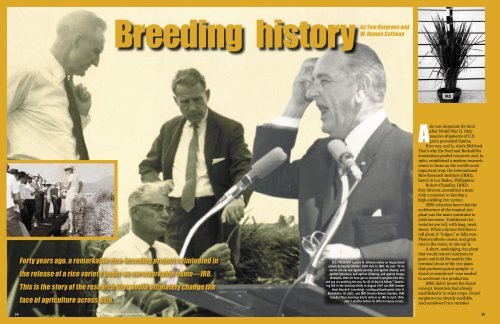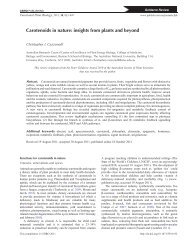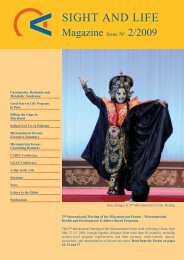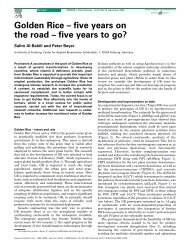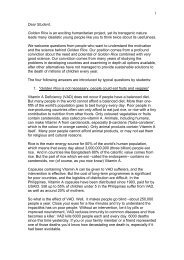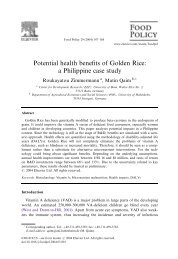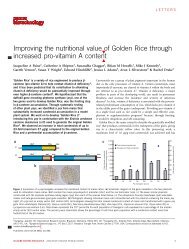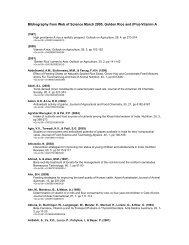Breeding History - The Golden Rice Project
Breeding History - The Golden Rice Project
Breeding History - The Golden Rice Project
Create successful ePaper yourself
Turn your PDF publications into a flip-book with our unique Google optimized e-Paper software.
34<br />
Forty years ago, a remarkable rice-breeding project culminated in<br />
the release of a rice variety under an unremarkable name—IR8.<br />
This is the story of the research that would ultimately change the<br />
face of agriculture across Asia.<br />
<strong>Breeding</strong> history<br />
<strong>Rice</strong> Today October-December 2006<br />
by Tom Hargrove and<br />
W. Ronnie Coffman<br />
U.S. PRESIDENT Lyndon B. Johnson makes an impassioned<br />
speech during his October 1966 visit to IRRI. He said, “If we<br />
are to win our war against poverty, and against disease, and<br />
against ignorance, and against illiteracy, and against hungry<br />
stomachs, then we have got to succeed in projects like this,<br />
and you are pointing the way for all of Asia to follow.” Examining<br />
IR8 in the Institute fi elds in August 1967 are IRRI breeder<br />
Hank Beachell (crouching), visiting philanthropist John D.<br />
Rockefeller III (left), and IRRI Director Robert Chandler. IRRI<br />
breeder Peter Jennings briefs visitors on IR8 in April 1966,<br />
only 7 months before its offi cial release (inset).<br />
URBITO ONGLEO (3)<br />
Asia was desperate for food<br />
after World War II. Only<br />
massive shipments of U.S.<br />
grain prevented famine.<br />
<strong>Rice</strong> was, and is, Asia’s lifeblood.<br />
That’s why the Ford and Rockefeller<br />
foundations pooled resources and, in<br />
1960, established a modern research<br />
center to focus on the world’s most<br />
important crop: the International<br />
<strong>Rice</strong> Research Institute (IRRI),<br />
based in Los Baños, Philippines.<br />
Robert Chandler, IRRI’s<br />
fi rst director, assembled a team<br />
with a mission: to develop a<br />
high-yielding rice variety.<br />
IRRI scientists knew that the<br />
architecture of the tropical rice<br />
plant was the main constraint to<br />
yield increases. Traditional rice<br />
varieties are tall, with long, weak<br />
stems. When a farmer fertilizes a<br />
tall plant, it “lodges,” or falls over.<br />
Photosynthesis ceases, and grain<br />
rots in the water, or rats eat it.<br />
A short, nonlodging rice plant<br />
that would convert nutrients to<br />
grain and hold the panicle (the<br />
terminal shoot of the rice plant<br />
that produces grain) upright—a<br />
dwarf or semidwarf—was needed<br />
to accelerate rice production.<br />
IRRI didn’t invent the dwarf<br />
concept. Scientists had already<br />
established it in other crops. Dwarf<br />
sorghum was already available.<br />
And semidwarf rice varieties<br />
35<br />
IRRI
THE TALL Peta variety, one of IR8’s parents, towers over<br />
its more resilient offspring. Because of its shorter, stouter<br />
stature, IR8 was less prone to lodging (falling over), which<br />
caused severe yield losses in the taller traditional varieties.<br />
had already been developed and<br />
released in mainland China, largely<br />
unknown to the rest of the world.<br />
More significant, in 1946, S.C.<br />
Salmon, a geneticist with General<br />
Douglas MacArthur’s Occupation<br />
Army in Japan, had sent seeds of<br />
Norin 10, a dwarf wheat variety that<br />
he found in a Japanese agricultural<br />
experiment station, to Orville Vogel at<br />
Washington State University. Within<br />
a few years, Dr. Vogel had developed<br />
Gaines, a semidwarf wheat variety<br />
that spread rapidly across the U.S.<br />
Pacific Northwest. Vogel sent seeds<br />
with the Norin 10 dwarfing gene to<br />
Norman Borlaug of the Rockefeller<br />
Foundation wheat program in<br />
Mexico. Dr. Borlaug used those seeds<br />
to breed semidwarf wheat varieties.<br />
<strong>The</strong> most successful was 8156—given<br />
that name for Dr. Borlaug’s 8,156th<br />
cross. 8156 yielded bountifully<br />
and made Mexico self-sufficient in<br />
wheat production by the mid-1960s.<br />
Seeds of 8156 spread to Pakistan,<br />
where it was called “MexiPak,”<br />
then to Turkey, Iran, and India.<br />
In 1949, the Food and Agriculture<br />
Organization of the United Nations<br />
established the International <strong>Rice</strong><br />
Commission, which commissioned an<br />
indica-japonica hybridization project<br />
based in Cuttack, India. Its mission<br />
was to cross the short japonica, or<br />
temperate, rice with taller indica, or<br />
tropical, varieties, to develop shortstatured<br />
varieties with higher yield<br />
potential. Shorter rice varieties such<br />
as ADT 27 and Mahsuri, selected<br />
from the japonica × indica crosses,<br />
were widely planted across the<br />
Indian subcontinent in the 1960s.<br />
36<br />
Meanwhile, U.S. rice breeders<br />
were irradiating seeds of tall<br />
U.S. varieties, hoping to induce<br />
a short-statured mutant. Among<br />
those pioneers were Nelson Jodan<br />
of Louisiana State University’s<br />
rice research center in Crowley,<br />
Louisiana, and Henry (“Hank”)<br />
Beachell of the Texas A&M University<br />
rice research center near Beaumont,<br />
Texas. But their selections had high<br />
sterility and were not successful.<br />
In 1957, the Rockefeller<br />
Foundation sent Peter Jennings, a<br />
young plant pathologist, to Arkansas,<br />
Texas, and Louisiana to learn about<br />
rice in order to develop new rice<br />
varieties for Latin America. <strong>The</strong><br />
Rockefeller Foundation then sent Dr.<br />
Jennings to Mexico and Colombia.<br />
Dr. Jennings and Sterling<br />
Wortman, later to become IRRI’s<br />
associate director, traveled across<br />
Asia in 1960, looking at rice<br />
varieties, meeting rice scientists, and<br />
interviewing prospective trainees<br />
and staff. “Be on the lookout for<br />
a dwarf rice,” Dr. Beachell recalls<br />
advising them. Dr. Beachell visited<br />
the fledgling IRRI as a consultant in<br />
1962, then returned to Beaumont.<br />
In India, Drs. Jennings and<br />
Wortman encountered Taichung<br />
Native 1 (TN1), a Taiwanese<br />
variety that was probably the first<br />
widely grown semidwarf variety<br />
in the tropics. TN1 yielded far<br />
better than tall varieties, but<br />
was highly susceptible to major<br />
disease and insect pests.<br />
Dr. Jennings joined IRRI as<br />
head of the Varietal Improvement<br />
Department in 1961. Among the<br />
<strong>Rice</strong> Today October-December 2006<br />
IRRI<br />
GENE HETTEL<br />
germplasm assembled at that time<br />
was Dee-geo-woo-gen (DGWG) from<br />
China, a parent of TN1, and clearly<br />
its source of dwarfism. But at that<br />
time the nature of inheritance of<br />
DGWG’s short stature was unknown.<br />
Dr. Chandler described DGWG<br />
as “a high-yielding, heavy-tillering,<br />
short-statured variety from Taiwan.”<br />
Dr. Jennings and Akiro Tanaka,<br />
hired from Japan as IRRI’s first<br />
plant physiologist, conceptualized<br />
the semidwarf rice plant and<br />
systematically studied the causes,<br />
and effects, of lodging during IRRI’s<br />
first 3 years. In his 1982 book, An<br />
adventure in applied science: a<br />
history of the International <strong>Rice</strong><br />
Research Institute, Dr. Chandler<br />
wrote about lodging research:<br />
By supporting tall varieties such as<br />
Peta and MTU-15 with bamboo sticks,<br />
Jennings found that tall varieties yielded<br />
essentially as well as did lodging-resistant<br />
varieties. Moreover, the lodging-susceptible<br />
varieties, when supported, responded well<br />
to nitrogen applications, whereas the<br />
unsupported plants showed a decided<br />
negative response. … This proved beyond<br />
doubt that lodging per se was the primary<br />
cause of low yields when traditional<br />
tropical varieties were subjected to modern<br />
management methods.<br />
Dr. Chandler made several<br />
references to IRRI’s breeding<br />
objectives in the first IRRI<br />
Annual Report (1961-62). <strong>The</strong><br />
section “Varietal Improvement”<br />
almost gives a blueprint for the<br />
AFTER A BUMPER crop in his first season growing<br />
IR8, Indian farmer K.N. Ganesan was so<br />
moved by the new variety that he named his<br />
second son in its honor—IR-ettu in Tamil, and<br />
signed as Irettu. Here, father and son stand in<br />
a field of a different variety, IR50, in 1983.
variety, yet to be developed, that<br />
several years later would turn<br />
rice production on its head:<br />
It would seem that the following plant type<br />
might be useful in the near future throughout<br />
much of the tropics—a combination of<br />
short, stiff culms bearing erect, moderately<br />
sized, dark-green leaves; responsiveness in<br />
yield to fertilizer; mid-season maturity and<br />
in most cases, photoperiod sensitivity to<br />
permit double cropping practices. <strong>The</strong>se<br />
objectives are being pursued […] with both<br />
indica by indica and indica by japonica<br />
hybridization.<br />
Not much was known about<br />
the genetics of tropical rice<br />
varieties at the time, so IRRI<br />
hired a geneticist—Te Tzu Chang,<br />
from Taiwan—in its first group of<br />
scientists. Dr. Chang began studying<br />
the inheritance of plant height.<br />
Jennings made 38 crosses in late<br />
1962; 11 of them included the dwarf<br />
parent DGWG, TN1, or I-geo-tze<br />
(IGT)—another dwarf from Taiwan.<br />
<strong>The</strong> eighth IRRI cross—from<br />
which IR8 was eventually selected—<br />
was of Peta, a tall, vigorous variety<br />
from Indonesia, and DGWG.<br />
From that cross, 130 seeds were<br />
formed. Those seeds were planted<br />
in pots in IRRI’s screenhouse<br />
and produced the first, or F 1,<br />
generation of plants. All were tall.<br />
Seeds from the F 1 plants were<br />
sown in the field, and produced about<br />
10,000 second-generation (F 2) plants<br />
that segregated by height in a ratio of<br />
three talls to one dwarf. Dr. Jennings<br />
immediately recognized this as a<br />
Mendelian ratio—named after Gregor<br />
Mendel, who became known as the<br />
father of genetics for his 19th-century<br />
research into the inheritance of traits<br />
in pea plants. This was a key result—it<br />
meant that dwarfism in DGWG<br />
was controlled by a single gene and<br />
was therefore simply inherited,<br />
making the job of developing a<br />
commercially usable semidwarf<br />
variety immeasurably easier.<br />
Dr. Jennings immediately<br />
brought Drs. Chandler and Wortman<br />
to the field to see the segregating<br />
plants. He then cabled the good news<br />
to Dr. Beachell in Texas. “That’s<br />
when we knew we had it [meaning<br />
that DGWG could be used to breed<br />
an improved semidwarf variety],”<br />
Dr. Beachell recalled years later.<br />
With this discovery, Dr. Jennings<br />
persuaded Drs. Chandler and<br />
Wortman to exchange a cytogenetics<br />
position in the Varietal Improvement<br />
program for a second breeder to<br />
help with the increase in field work<br />
that would obviously come. <strong>The</strong>y<br />
agreed, and Dr. Jennings suggested<br />
Dr. Beachell, who arrived in 1963.<br />
Tall, late-maturing plants<br />
from the Peta-DGWG cross were<br />
discarded, and only short, earlymaturing<br />
plants were saved.<br />
Seeds were “bulked” and planted<br />
in a nursery where they could be<br />
screened for susceptibility to the rice<br />
blast fungus. In 1963, Dr. Jennings<br />
departed IRRI for study leave,<br />
leaving the material in the hands of<br />
newly arrived Dr. Beachell. From the<br />
third (F3) generation, Dr. Beachell<br />
selected 298 of the best individual<br />
plants. Seeds from each plant<br />
were sown as individual “pedigree<br />
rows”—the fourth (F4) generation.<br />
From row 288, a single<br />
plant—the third one—was selected<br />
and designated IR8-288-3. Its<br />
seeds, the F5 or fifth generation,<br />
were grown to produce the<br />
basic IR8-288-3 seed stock.<br />
IR8-288-3—which was eventually<br />
named as variety IR8—was a<br />
semidwarf rice, about 120 cm tall<br />
with strong stems that held the<br />
plant upright, even when heavily<br />
fertilized. It was also nonsensitive<br />
IRRI STAFF load IR8<br />
seeds for distribution<br />
to farmers in 1966.<br />
<strong>Rice</strong> Today October-December 2006<br />
to photoperiod, or daylength,<br />
scientists would later learn. That<br />
meant it could be grown in many<br />
latitudes, at any time of the year.<br />
“<strong>The</strong> seed [of IR8] was uniform<br />
enough for trials in other countries,<br />
but a couple of years later Dr.<br />
Beachell devoted considerable<br />
effort to producing an extremely<br />
pure strain that would serve as<br />
a uniform seed source of IR8 for<br />
the future,” Dr. Chandler wrote.<br />
Meanwhile, seeds of IR8-288-<br />
3 and other promising lines were<br />
being sent for testing by national<br />
rice programs across Asia.<br />
“IRRI’s policy was free access<br />
to all of our genetic material,”<br />
Dr. Beachell said. “It was made<br />
available to the world.”<br />
In the 1966 dry season, S.K. De<br />
Datta, a young Indian agronomist<br />
who had joined IRRI in early 1964,<br />
examined the fertilizer response<br />
of IR8, along with other rice<br />
varieties. “We wanted to determine<br />
maximum yields under the best<br />
management possible,” he said.<br />
Dr. De Datta was amazed<br />
when he harvested the trials in<br />
May. IR8 averaged 9.4 tons per<br />
hectare, yielding as high as 10.3<br />
tons per hectare in one trial.<br />
Average yields in the Philippines<br />
then were about 1 ton per hectare.<br />
Dr. De Datta took his yield<br />
data to Dr. Jennings, then to<br />
Dr. Beachell. “Let’s go see Bob<br />
[Chandler],” Dr. Beachell said.<br />
But, at that moment, Dr.<br />
37<br />
IRRI
IRRI<br />
Chandler was chairing a seminar—<br />
the news would have to wait another<br />
hour. After what seemed much<br />
longer, Drs. Beachell and De Datta<br />
fi nally saw their director. Sensing<br />
the pair’s excitement, Dr. Chandler<br />
suggested they move to his offi ce.<br />
Dr. De Datta showed his data,<br />
and Dr. Chandler was excited.<br />
“<strong>The</strong> whole world will hear about<br />
this,” Dr. Chandler said. “We’re going<br />
to make history!” He then shook<br />
hands, congratulating Dr. Beachell for<br />
helping develop IR8 and Dr. De Datta<br />
for discovering and demonstrating<br />
the semidwarf’s yield potential.<br />
“<strong>The</strong> IR8 yield data were the most<br />
exciting thing that ever happened<br />
to me,” Dr. De Datta later recalled.<br />
Soon, similar reports of dramatic<br />
yield increases were coming to<br />
IRRI from across Asia, including<br />
11-ton harvests in Pakistan.<br />
Dr. De Datta prepared his<br />
widely published “yield response”<br />
graph, showing how yields of IR8<br />
rose with increased fertilization,<br />
while those of traditional varieties<br />
actually declined (see fi gure above).<br />
Philippine President Ferdinand<br />
Marcos heard about the new rice, and<br />
fl ew to IRRI by helicopter on 3 June<br />
1966. Dr. Jennings and others briefed<br />
the president by a plot of IR8 next<br />
to Peta, a tall, traditional variety.<br />
Dr. De Datta recalls President<br />
Marcos’s reaction: “Do you mean<br />
that little rice can out-produce our<br />
vigorous Philippine varieties?”<br />
the president asked. Dr. De Datta<br />
assured him that it could.<br />
“No kidding?” Marcos responded.<br />
President Marcos soon ordered<br />
that IR8 seeds be multiplied as<br />
IR8 PICTURED next to its parents:<br />
Peta, a tall, vigorous variety from<br />
Indonesia, and the Taiwanese dwarf<br />
variety DGWG.<br />
38<br />
THE RESPONSE TO nitrogen fertizer of two semidwarf<br />
rice varieties—IR8 and Taichung Native 1—and<br />
of Peta, a tall, traditional variety, in the 1966 dry<br />
season on IRRI’s experiment farm.<br />
rapidly as possible. Marcos’s<br />
goal was to make the Philippines<br />
self-suffi cient in rice production<br />
during his fi rst term of offi ce.<br />
It was. During the last half<br />
of 1966 alone, 2,359 Philippine<br />
farmers came to IRRI by bus, on<br />
bicycle, and on foot, from 48 of the<br />
country’s 56 provinces, to get seeds.<br />
<strong>The</strong> new rice yielded bountifully,<br />
but had major disadvantages.<br />
Foremost was its bold, chalky grain,<br />
which distracted from its market<br />
appearance as polished rice. <strong>The</strong><br />
grain also had high breakage during<br />
milling. And IR8 had high amylose<br />
content, which made it harden after<br />
cooling. (Dr. Beachell remembers a<br />
young Filipina saying, “I don’t like<br />
<strong>Rice</strong> Today October-December 2006<br />
IR8 because it scratches my throat.”)<br />
Dr. Beachell recalls the<br />
consensus view of the IRRI seed<br />
committee: “We needed to move<br />
as fast as possible. <strong>The</strong>re was not<br />
enough rice to go around. We had<br />
to have something to alleviate the<br />
rice shortage. Enough rice was more<br />
important than grain quality.<br />
“So, would we release the line<br />
as a variety, or wait to improve it?<br />
We knew IR8’s limitations, but also<br />
knew we had the plant type. IR8<br />
would be the prototype for future<br />
varieties. We decided to spread it.”<br />
<strong>The</strong> seed committee decided to<br />
formally name IR8-288-3 as IR8<br />
on 14 November 1966. <strong>The</strong> news<br />
was released on 28 November.<br />
Dr. Chandler later wrote:<br />
He [Beachell], Jennings, and Chang made<br />
a fi ne team. When I was asked, some years<br />
later, who, among the three senior scientists<br />
in the Varietal Improvement Department,<br />
should receive the coveted John Scott<br />
Award for the creation of IR8, I replied that<br />
the prize should be split among the three:<br />
Jennings for selecting the parents and<br />
making the cross, Beachell for identifying<br />
IR8-288-3 from among the multitude of<br />
segregating lines, and Chang for having<br />
brought to the immediate attention of<br />
IRRI breeders at the start the value of the<br />
short-statured varieties from Taiwan such<br />
as Dee-geo-woo-gen, I-geo-tze, and<br />
Taichung Native 1.<br />
Pioneer rice scientists such as<br />
Drs. Jennings, Beachell, Chang,<br />
and De Datta, as well as others who<br />
played key roles in developing and<br />
testing IR8—such as Dr. Tanaka and<br />
another plant physiologist, Benito<br />
Vergara—proved Dr. Chandler right.<br />
IR8, and IRRI, did indeed “make<br />
history.” IR8 changed the world food<br />
situation and initiated what is now<br />
called the Green Revolution in rice.<br />
Tom Hargrove, a former IRRI editor, is now<br />
coordinator, Information and Communications<br />
Unit at IFDC, an International Center for Soil<br />
Fertility and Agricultural Development in<br />
Alabama, USA (Tomhar66@swbell.net).<br />
W. Ronnie Coffman, a former IRRI rice breeder,<br />
is now international professor of plant breeding<br />
and director of international programs,<br />
College of Agriculture and Life Sciences at<br />
Cornell University in New York, USA.


